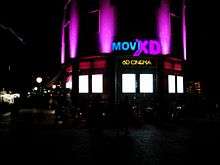Cinema of Cyprus
| Cinema of Cyprus | |
|---|---|
 Movie XD 6D cinema in Nicosia | |
| Number of screens | 30 (2011)[1] |
| • Per capita | 2.9 per 100,000 (2011)[1] |
| Main distributors |
Four Stars Films 40.7% Odeon Cyprus 23.3% Feelgood 18.9%[2] |
| Produced feature films (2011)[3] | |
| Fictional | 2 |
| Animated | - |
| Documentary | 1 |
| Number of admissions (2011)[4] | |
| Total | 870,000 |
| • Per capita | 1 (2012)[5] |
| Gross box office (2011)[4] | |
| Total | €7.11 million |
Cypriot cinema was born much later than that of other countries. In the late 1960s and early 1970s, George Filis produced and directed Gregoris Afxentiou, Etsi Prodothike i Kypros (Cyprus Betrayal), and The Mega Document.
In 1994, cinematographic production received a boost with the establishment of the Cinema Advisory Committee. As of the year 2000, the annual amount set aside in the national budget stands at Cy Pounds 500,000 (about 850,000 Euros). In addition to government grants, Cypriot co-productions are eligible for funding from the Council of Europe's Eurimages Fund, which finances European film co-productions. To date, four feature-length films in which a Cypriot was executive producer have received funding from Eurimages. The first was I Sphagi tou Kokora (1992), completed in 1996, Hellados (And the Trains Fly to the Sky, 1995), which is currently in post-production, and Costas Demetriou's O Dromos gia tin Ithaki (The Road to Ithaka, 1997) which premiered in March 2000. The theme song to The Road to Ithaka was composed by Costas Cacoyannis and sung by Alexia Vassiliou. In September 1999, To Tama (The Promise) by Andreas Pantzis also received funding from the Eurimages Fund.[6] In 2009 the Greek director, writer and producer Vassilis Mazomenos filmed in Cyprus Guilt. The film was awarded in 2012 with the Best Screenwriting and Best Photography award in London Greek Film Festival (UK) and was official selection in Montreal World Film Festival, Cairo International Film Festival, India International Film Festival, Tallinn Black Nights Film Festival, Fantasporto and opening film in the Panorama of European Cinema in Athens. In 2010 the film was Nominated for the best film from the Hellenic Film Academy.
Only a small number of foreign films have been made in Cyprus. This includes Incense for the Damned, filmed in 1969 and starring Patrick Macnee, Patrick Mower and Peter Cushing. In 1970 The Beloved, starring Raquel Welch was also filmed in Cyprus, as was the 1973 British comedy movie Ghost in the Noonday Sun, directed by Peter Medak, starring Peter Sellers, Anthony Franciosa and Spike Milligan.[7] Parts of the 1962 film The Longest Day, starring John Wayne were also filmed on Cyprus.
The most renowned Cypriot director to have worked abroad is Michael Cacoyannis.
Films
See also
- Cinema of the world
- World cinema
- Cyprus International Film Festival
- Culture of Cyprus
- Culture of Greece
- Culture of Turkey
- List of Greek actors
- List of Turkish actors
- Film
- Cinema of Greece
- Cinema of Turkey
- List of Cypriot films
- History of Cyprus
- Peter Polycarpou
- Derviş Zaim
- Michael Cacoyannis
- Nicolas Economou
References
- 1 2 "Table 8: Cinema Infrastructure - Capacity". UNESCO Institute for Statistics. Retrieved 5 November 2013.
- ↑ "Table 6: Share of Top 3 distributors (Excel)". UNESCO Institute for Statistics. Retrieved 5 November 2013.
- ↑ "Table 1: Feature Film Production - Genre/Method of Shooting". UNESCO Institute for Statistics. Retrieved 5 November 2013.
- 1 2 "Table 11: Exhibition - Admissions & Gross Box Office (GBO)". UNESCO Institute for Statistics. Retrieved 5 November 2013.
- ↑ "Country Profiles". Europa Cinemas. Retrieved 9 November 2013.
- ↑ "Film Birth – History of Cinema – Cyprus".
- ↑ Roger Lewis, The Life and Death of Peter Sellers (London: Arrow, 1995) p.130
